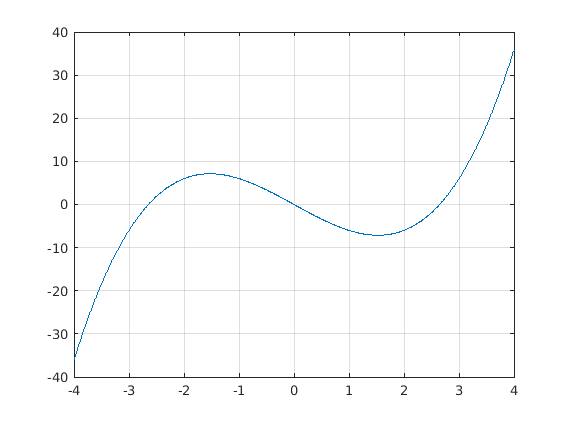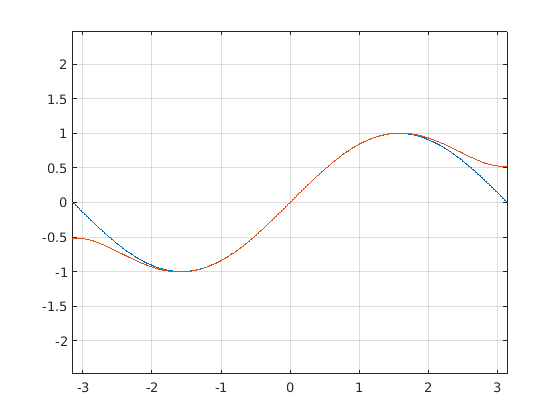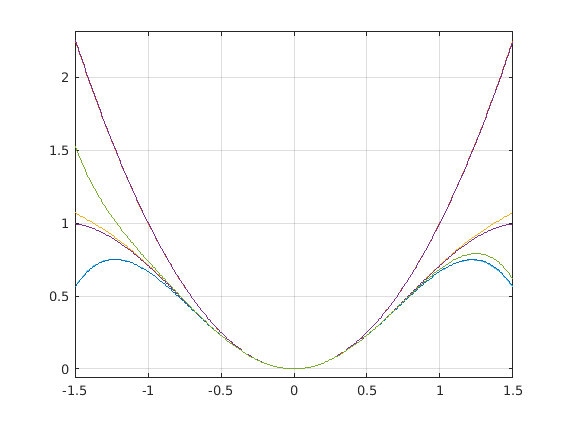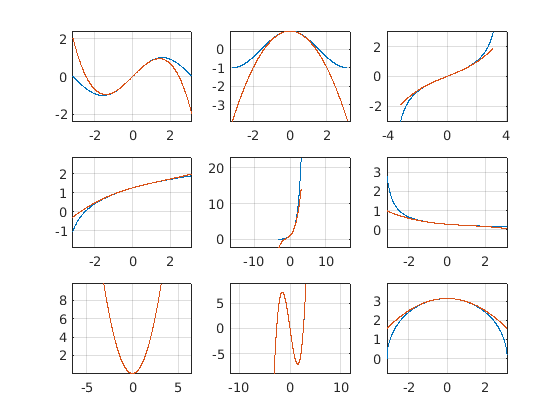Contents
Assignment 5
import tests.*
Testing factorials
fact_test_1();
fact_test_2();
Testing fact():
0! = 1, 5! = 120, 7! = 5040
Testing fact() : computing binomial coefficients
The fifth row of Pascal triangle is:
1 5 10 10 5 1
Testing polynomial evaluation
eval_test_1();
eval_test_2();
Testing eval() with p(x)=2 + 3x + 5x^2 + 7x^3:
p(0) = 2, p(1) = 17, p(2) = 84
Testing eval() with p(x)=1 + x + x^2 + ... + x^n:
p(1/2) = 1.998047e+00 (should be approximately ___)
p(1/3) = 1.499975e+00 (should be approximately ___)
p(1/5) = 1.250000e+00 (should be approximately ___)
Testing vectorized polynmomial evaluation
vect_eval_test_1();
vect_eval_test_2();
Testing vect_eval() with p(x)=2 + 3x + 5x^2 + 7x^3:
p(x) for x = [0 1 2] is:
2 17 84
Testing vect_eval() with p(x)=x^3 - 7x to plot p(x):

Testing taylor polynomial
taylor_test_1();
taylor_test_2();
taylor_test_3();
taylor_test_4();
Testing taylor_poly(), test1:
@(x)2+3*x.^2+5*x.^3+7*x.^4
T4 of f should be [2 0 3 5 7]:
2.0000 0.0030 3.0150 5.0420 7.0000
Testing taylor_poly(), test 2:
T5 of sin(x) should be ____
0 1.0000 -0.0005 -0.1667 0.0001 0.0083
Testing taylor_poly, test 3:
T5 of log(x) around x=1:
0 0.9995 -0.4990 0.3318 -0.2480 0.1828
Testing taylor_poly, test 4:
T5 of sqrt(x) around x=1:
1.0e+11 *
0 0.0000 -0.0000 0.0000 -0.0058 1.0921
Testing plotting taylor polynomial, part 1
plot_compare_test_1();

Testing plotting taylor polynomial, part 2
plot_compare_test_2();

Taylor plot bonanza!
taylor_plot_bonanza();

Functions
function [nf] = fact(n)
nf = 1;
for k = 1:n
nf = nf * k;
end
end
function [val] = peval(p, x)
val = sum(p.*(x.^[0:length(p)-1]));
end
function [vals] = vect_peval(p,x)
vals = arrayfun(@(x) peval(p,x),x);
end
function [p] = taylor_poly(f, n)
h = 0.001;
p = zeros(1,n+1);
fv = zeros(n+1);
for r=1:n+1
fv(1,r) = f(h*(r-1));
end
p(1) = fv(1,1);
for r=2:n+1
for c = 1:n+2-r
fv(r, c) = (fv(r-1,c+1) - fv(r-1, c))/h;
end
p(r) = fv(r,1)/fact(r-1);
end
end
function [] = plot_compare(f, a, b, n)
p = taylor_poly(f,n);
x = [a:0.01:b];
plot(x,f(x),x,vect_peval(p,x));
grid on
axis equal
end
Test code
classdef tests
methods(Static = true)
function fact_test_1()
disp('Testing fact():');
fprintf('0! = %d, 5! = %d, 7! = %d\n', fact(0), fact(5), fact(7));
end
function fact_test_2()
disp('Testing fact() : computing binomial coefficients');
disp('The fifth row of Pascal triangle is:');
R5=zeros(5,1);
for i = 0:5
R5(i+1) = fact(5)/(fact(i)*fact(5-i));
end
disp(R5');
end
function eval_test_1()
disp('Testing eval() with p(x)=2 + 3x + 5x^2 + 7x^3:');
p = [2 3 5 7];
fprintf('p(0) = %d, p(1) = %d, p(2) = %d \n',peval(p,0), peval(p,1), peval(p,2));
end
function eval_test_2()
disp('Testing eval() with p(x)=1 + x + x^2 + ... + x^n:');
N = 10;
p = ones(1,N);
fprintf('p(1/2) = %d (should be approximately ___)\n', peval(p, 1/2));
fprintf('p(1/3) = %d (should be approximately ___)\n', peval(p, 1/3));
fprintf('p(1/5) = %d (should be approximately ___)\n', peval(p, 1/5));
disp('');
end
function vect_eval_test_1()
disp('Testing vect_eval() with p(x)=2 + 3x + 5x^2 + 7x^3:');
p = [2 3 5 7];
x = [0 1 2];
disp('p(x) for x = [0 1 2] is:');
disp(vect_peval(p,x));
disp('');
end
function vect_eval_test_2()
disp('Testing vect_eval() with p(x)=x^3 - 7x to plot p(x):');
figure('Name', 'Plot of of x^3-7x');
p = [0 -7 0 1];
x = [-4:0.01:4];
plot(x,vect_peval(p,x));
grid on
end
function taylor_test_1()
f = @(x) 2 + 3*x.^2 + 5*x.^3 + 7*x.^4;
T4 = taylor_poly(f,4);
disp('Testing taylor_poly(), test1:');
disp(f)
disp('T4 of f should be [2 0 3 5 7]:');
disp(T4);
disp('');
end
function taylor_test_2()
f = @(x) sin(x);
T5 = taylor_poly(f,5);
disp('Testing taylor_poly(), test 2:');
disp('T5 of sin(x) should be ____');
disp(T5);
disp('');
end
function taylor_test_3()
f = @(x) log(1+x);
T5 = taylor_poly(f,5);
disp('Testing taylor_poly, test 3:');
disp('T5 of log(x) around x=1: ');
disp(T5);
disp('');
end
function taylor_test_4()
f = @(x) sqrt(x);
T5 = taylor_poly(f,5);
disp('Testing taylor_poly, test 4:');
disp('T5 of sqrt(x) around x=1: ');
disp(T5);
disp('');
end
function plot_compare_test_1()
figure('Name','Taylor polynomial T3 approximating sin(x)');
f = @(x) sin(x);
plot_compare(f, -pi, pi, 3);
plot_compare(f, -pi, pi, 5);
end
function plot_compare_test_2()
figure('Name','Taylor polynomials approaching the function');
f = @(x) sin(x).^2;
for i=2:7
plot_compare(f, -3/2, 3/2, i);
hold on
end
end
function taylor_plot_bonanza()
figure('Name','Taylor polynomial bonanza');
func_array = {{@(x) sin(x), @(x) cos(x), @(x)tan(x*0.4)};
{@(x) log(x+3.5), @(x) exp(x), @(x) 1./(x+3.5)};
{@(x) x.^2, @(x) x.^3 - 7*x, @(x) sqrt(pi^2-x.^2)}};
pos = 1;
for i=1:3
for j=1:3
subplot(3,3, pos);
plot_compare(func_array{i}{j}, -pi, pi, 3);
pos = pos + 1;
end
end
end
end
end



